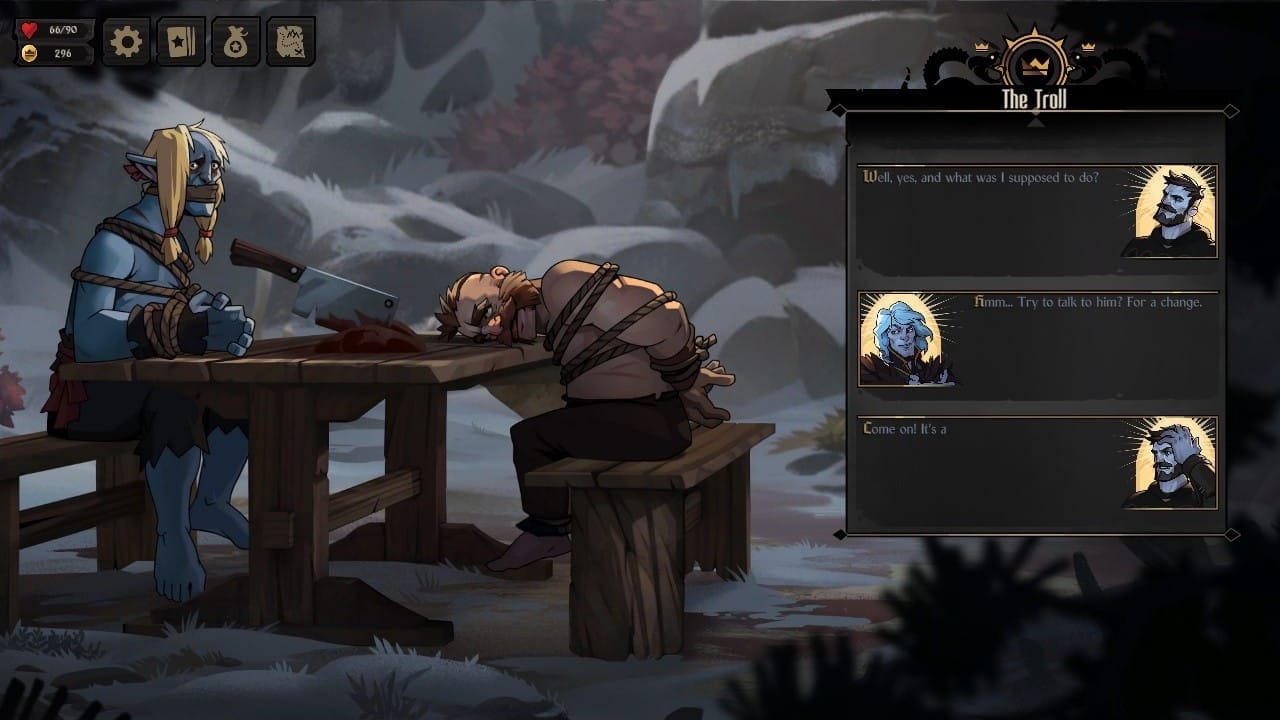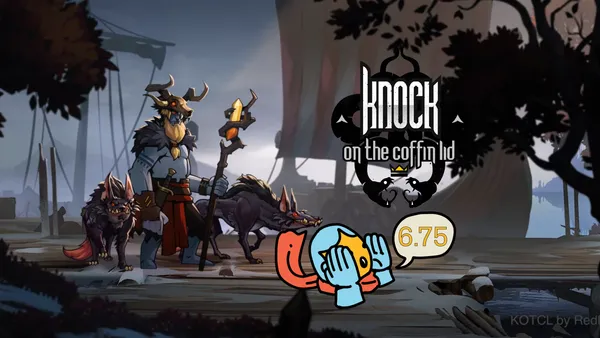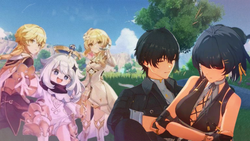I have this nasty habit of letting my first hour of a game decide whether or not it is “worthy” of my time. Now, pair that with my ever-waning attention span, and you might be able to understand just how rare it is to get me hooked on anything that requires me to pause my Spotify playlist. This is doubly true if my rotted brain has already deemed something as “eh”. But, on some very rare occasions, a parasitic dopamine worm nests its way into my cerebrum, forcing me back to my screen. Developer RedBoon’s Knock on the Coffin Lid did exactly that, parasite and all.
Knock on the Coffin Lid is a deck building roguelike that follows the Slay the Spire formula with some unique and refreshing twists that take some time to get into. The opening of the game has you run through the tutorial as a nameless soldier, teaching you the most basic of its mechanics. Your hero is attributed the familiar attack and defense cards with some status change cards in the mix. More familiarity ensues when introduced to the shop, loot system, and card progression, all systems you’d come to expect from a game in this genre.
Slay the Coffin Lid

In the first few minutes, I noticed the art was filled with such a unique grimdark personality, however, I was not initially blown away. Like others, I have sifted through countless illustrated interpretations of mystical medieval fantasies. (Just ask about my Pinterest boards!). Early on the artwork is solid but rather simple in nature. But this is quickly remedied after the first map. I do wish the named characters displayed more personality and characterization through their art style.
Unfortunately, this was not the case. Most of the eye-catching designs came from the uniquely dynamic enemy design. Clear artistic expertise was at work when crafting these high fantasy beasts. There were many encounters where I spent an extra moment before playing my cards squinting at a bulbous sore on an enemy, a nagging fear that it was gonna hatch into another monster… and sure enough, it did. Clearly there were some creative juices poured directly into the enemy design, but not so much for the named characters.
What started as a rather straightforward story eventually turned more intriguing in nature. After learning from a mysteriously vampiric-looking twink named Mortis that he and his royal cohort were killed by poison-laced wine during a ceremonial gathering, and after dying several times when trying to seek revenge for his beloved best friend King Ingvar, Mortis reveals to you that the starting protagonist Persival is in fact immortal. Mortis does not reveal the how or why of his plans, because yuh know, we have a roguelike to play. The setup to the journey certainly sparked a tinge of interest with the whole betrayal and mysterious plan plotline, but what really pulled me in was exactly how we’d go about solving this mystery. Beginning your adventure with an overworld map felt like an interesting choice at first. Every plot you move gets revealed so each run you can see exactly what “action” may take place on a given mark. The real fun happens at the points of the map where dialogue choices are to be made. These choices drastically affect the outcome of the run, giving you rewards, buffs, or even curses depending on your dialogue choice. There is a fair bit of humor in these choices and even twists that can occur in the moment-to-moment text-based dialogue.

In one of my early runs, I found myself on the same side as a drunken dwarf and ended up helping him bar fight an elf. The dwarf would randomly attack me, wasting his turn to do damage to my posterior. Even further in, one of my choices led to me facing what I can only describe to you as a wendigo set in a medieval setting. These choices and their outcomes are really what keeps every run fresh. One moment you think you’ve plotted out every step to the area boss, perfect build and all. And then you meet a new NPC who offers you a “free magic card” that actually curses you so that every time it appears in your hand you lose half your health and all of your sanity. Knock on the Coffin Lid kept me from min-maxing too close to the sun in a way that was far more engaging than just throwing random overpowered bosses in the mix. Each death felt earned through my own choices, leaving me to only have my poor conversational skills to blame. During my playthrough the atmosphere of the game really began to come to life after getting past the first map. Seeing the variance in biomes, creatures, and character designs really showcases the art direction RedBoon is going for. Every character looks like they would fit perfectly on a trading card. There is not a single item in the game that looks boring, with even the starting sword looking dope as hell. Every animation has that story book feel which really doubles down on the fantasy of it all.
Toss a coin to your Coffin Lid

I’ve seen some thematic comparisons to The Witcher around the internet, which to me is a bit of a stretch. Sure, there are various humanoid races politically at odds due to age old conflicts. Yeah, every monster has that “genetically made just to kill humans” look. Absolutely, the demon spirit lady is kinda hot. But what I felt Knock on the Coffin Lid was lacking is the impressionable charm and charisma that The Witcher is so heavily known for. I found myself far more interested in the world than the characters themselves. I know that is a common criticism for any RPG or fantasy media but here I felt the named characters just lacked a certain sauce. I won’t get into spoiler territory but this does get slightly better as you meet more heroes, but that does not happen until a few hours into the game.
For at least four hours, you're stuck with Mortis and Persival’s lack of chemistry. Their dialogue had me hovering over the skip button despite how interested I was in the breadcrumbs of lore they were dropping along the way. The conversational blandness hampered what is an otherwise well plotted tale. The voice acting did the writing some favors, as the characters' designs matched their casting choices. Mortis had that sneaky wit and charming snark you’d expect out of a character of his station. And Persival had that knightley everyman tone that just oozes “I must stand for justice”. This just left me wishing they were given the opportunity to be more expressive with their lines. I felt there was a lot of room here to really play up on the drama and betrayal of it all. With such a dialogue-heavy game I felt I had to fight the dialogue just as much as the wretched beasts I encountered, which was a lot. Unlike the heart pumping thrill of those encounters, however, the moment-to-moment dialogue felt like it was engineered for me to be able to identify specific keywords of lore. My brain may be mush from years of SEO but every key lore noun felt strategically placed for optimally minimal attention keeping. For games that have such apparent care for their storytelling, I try my absolute hardest to skip as little dialogue as possible out of respect for the creators. But there was just little reason for me to not punch through and replace the dialogue moments with a second screened wiki.
With an already announced DLC expansion on the way, there is plenty of opportunity for the story and its characters to hit a good stride in the coming months. I could easily foresee returning to the game later in the year to explore new paths and dig even deeper into the world.Knock on the Coffin Lid is a stylistically unique game with familiar, albeit somewhat standard deck building mechanics. Its engaging interactivity within the narrative structure keeps the story engaging and worth playing despite disappointingly stiff characters. If lore and deck building is your thing and The Witcher Netflix show makes you empty inside, it is worth giving a shot at full price, and is a for-sure purchase if it ever goes on sale for less than 10 bucks.



